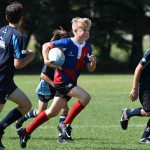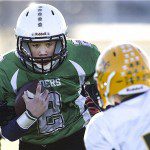
The Young Athlete: 3 Concepts for Parents & Coaches to Consider
Concept 1: Understanding and Accepting That Children Will Face Injury
With the amount of time now dedicated to training and the demands of competing at high levels, young athletes are faced with ever increasing opportunity for injury. I am a strong believer that education plays a major role in not only reducing injury, but also helping athletes and parents of young athletes to be aware of their body. In my opinion the most valuable commodity that we will ever possess is our health. Teaching children from a young age to exercise and eat right is obvious. But teaching young athletes to properly address problems with their body, helping them to understand injury, and as adults, respecting our children’s injuries, is paramount to their lifelong pursuits in exercise and health. Simply put, we must address injuries and pain in children in order to teach them to value and respect their body and prevent them from being turned off sport and athletics or, worse, being forced to quit the very sports they enjoy.
They start younger
With children beginning sport at younger ages, now as early as 4 years of age, and some children being asked to specialize in a sport that they show a predisposition to by age 7, the opportunity for injury has never been greater. There are other reasons that young athletes are more susceptible to injury: imbalances of strength and range of motion, growth cartilage being less resistant to microtrauma, anatomic malalignment issues, improper sizing of equipment (as children outgrow their equipment quickly or use inappropriate hand-me-downs), and, as noted above, the shear amount of highly intense training can all contribute to the increasing injuries young athletes are facing.
They shouldn’t just “suck it up”
The old adage of how our parents told us to “suck it up” simply does not suffice in today’s day and age. Concussion injuries have drawn a great deal of attention in the media and amongst parents of young athletes recently. Rightfully, we are taking these seriously and the term “suck it up” no longer applies. We know that cumulative or mis-treated head injury can have a lasting impact on an athlete. I simply ask why we don’t apply the same caution and perspective to injuries of the musculoskeletal system in young athletes.
Understanding and accepting that children will face injury in sport is the first step. The second step is knowing what to watch out for. The third is knowing what to do about it.
Concept 2: Knowing What to Watch Out For
Early recognition of injury is a critical factor in successfully and quickly returning your young athlete back to their sport safely. If you accept that children will heal quickly because they are children, then it is not normal when your child tells you that something has been hurting them for a few weeks. In my experience, when a child has a problem that is lurking and not obvious to sight, they will tell you about it. They may mention it in passing, or say it hurts during sport but then goes away, but if they continue to mention it over a period greater than a week then it warrants your attention.
There are several things that you might observe visually following an injury. A limp is not normal, especially if it is lasting more than a week. It can indicate a serious injury or one that is simply not resolving on its own. Any injury that demonstrates obvious swelling, loss of strength or a loss of motion should be dealt with immediately. Deformity and or total lack of use of the affected joint/region should really raise flags and warrants emergent care and sometimes x-ray.
What if it is not going away?
Most minor injuries in children will resolve in a few days. Nagging injuries that go untreated can turn into chronic problems that require a much longer time away from the sport and extended periods of treatment to allow the athlete to heal properly.
It is also important to mention that there are a myriad of childhood conditions and diseases that display musculoskeletal symptoms and it is important to rule them out, especially if the source of the injury is not certain. For example the treatment would differ for knee pain if the source is an acute sprain versus Osgood Schlatter’s Disorder. Pelvic or hip pain in a dancer may be an iliopsoas muscle strain, but congenital hip disorders must be ruled out.
Concept 3: Knowing What to Do About It
Start with listening
When a young athlete tells you that something hurts, pay attention. Actively inquire and gain some insight as to the nature of the injury. Was it immediate or did it occur slowly over time, when does it hurt, does it go away with rest or continually hurt. My article “Knowing Your Pain is Your Gain” gives some insight into how our body can tell us what is wrong and so I will not go any further on this topic, but what is important is that we teach a young athlete that their body has the ability to share what is wrong. They should listen as well as you. Please don’t dismiss their complaints until you have gotten the facts.
Follow the PRICE principal
Following an acute injury, apply the PRICE principal. Protection: to the best of your ability protect the injured area until it can be evaluated by a professional. This may mean using crutches or a sling and obviously depends on the area of the body involved. Rest: yes you heard me… rest is essential to the initial healing stages. It is alright for your young athlete to take a few days to determine the extent of injury. Utilize smart rest if it is appropriate, which implies that if one injured their shoulder, they could still ride a bike to keep up their cardiovascular fitness. If it is an ankle, perhaps they swim. In any event, rest is critical and should be utilized until an expert has assessed the injury. Ice: ice in the initial 48-72 hours can help to reduce the swelling and inflammation. Apply ice every hour for 15-20 minutes in the form of cold peas wrapped in a damp towel, crushed ice or an ice bath. Don’t sleep with ice or apply directly to the skin. Compression: an elastic wrap/compression/tensor sock should be used to reduce swelling. Always apply the wrap beginning below the injured area and wrapping upward, leaving toes/fingers exposed. Watch for numbness, discoloration or temperature changes (loosen wrap if needed) and do not sleep with wrap on the injured area. Elevation: this means keeping the injured area above the heart using gravity to help control early swelling.
In some instances the Emergency room or physician is appropriate but in most cases our physiotherapists will be able to assess, diagnose and implement treatment to minimize the short term and long term effects of the injury or condition. Our goal is to get them healed and out fast and without lasting problems, returning to their sport safely so they can continue to love sport.
“But I never needed physio when I was a kid”
I have heard many a parent state that they “never had physio when I was a kid” and while this is true, so too is the fact that most of us did not compete at the hours and the intensity at which our kids are. Just like awareness of concussions, our parents weren’t aware of the lasting consequences ignoring injuries may have had. Many of us who did suffer injury through our youth are finding out now, as the decades pass, how injuries not properly dealt with can haunt us later in life.
In Health, Grant Fedoruk
This information is not meant to replace the advice or treatment of a qualified physician or physiotherapist. It is meant for information only. Please seek an assessment and discuss your treatment options with your caregiver prior to making a decision about your treatment path.


